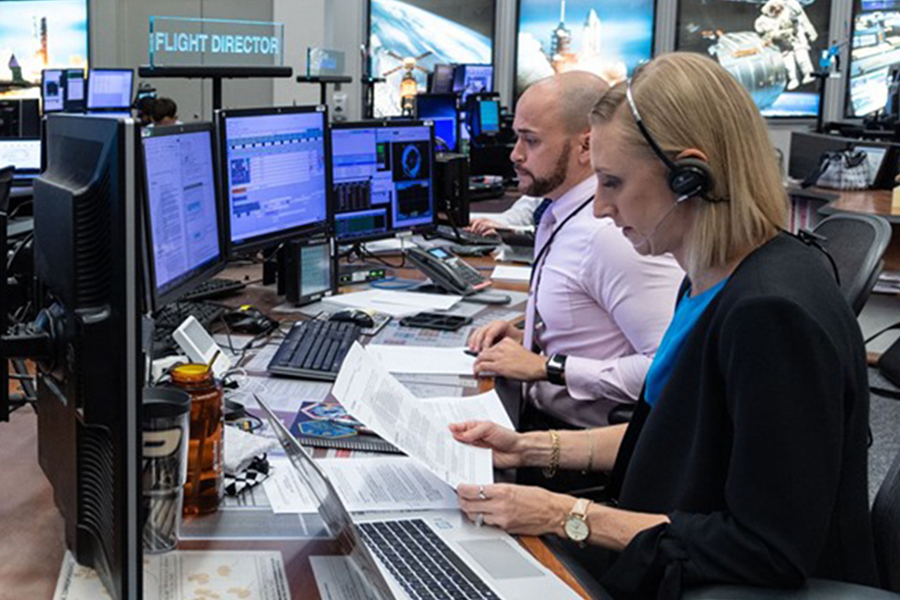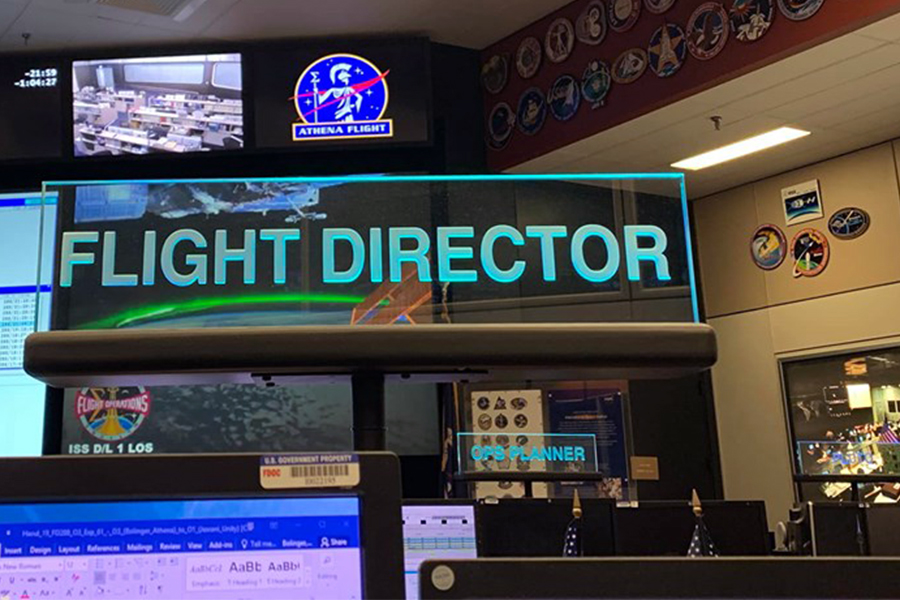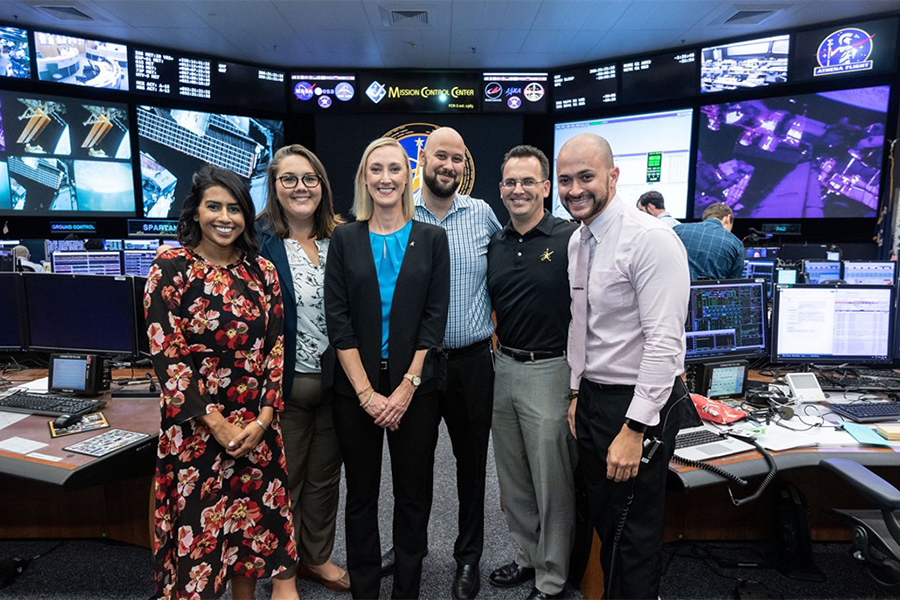Bolinger certified as NASA's 95th flight director

Allison Bolinger got the call the morning of June 26, 2018, to come to her “boss’s boss’s” office at NASA and was told she’d been selected as part of the 2018 Class of flight directors.
Immediately after the meeting, she called to share the good news with husband Jeremy. Immediately after hanging up, he started the research.
He knew how important selecting a team name is in the flight director certification process, so he read up on the 91 flight directors’ call signs, scouring the internet to see what would be perfect for the next in line. During a celebratory dinner that night — it just so happened to also be their wedding anniversary — when Allison said it was time to start the process of digging into what her call sign would be, Jeremy revealed the results of his investigation.
What about Athena, a goddess in Greek methodology who represents wisdom, courage and heroic endeavors?
“That’s perfect,” Allison said. “Done.”
Upon doing her own homework about Athena, Allison realized how fitting of a selection it was, reflecting on Athena’s attributes and drawing parallels to the challenges NASA faces as it reaches farther in the heavens.
Allison Bolinger (BSAAE ’04) will need to summon every ounce of wisdom gained from the 15-month certification process to keep astronauts aboard the International Space Station safe. She’ll need courage to help the agency push the bounds of human space exploration, knowing full well how risky a proposition it is to maintain a presence on the ISS and how difficult it will be to launch U.S. astronauts again from U.S. soil — and send them to the Moon and beyond. She can never lose focus on how heroic each endeavor is, keeping a warrior mentality, in a sense, by being strategic and deliberate undertaking each new adventure.
Every bit of being a flight director is weighty — the significance of the primary task of keeping the crew safe first, then the vehicle safe and then completing mission objectives, the realization of how substantial the role is to NASA’s contributions to advance space exploration and the responsibilities of leading a team of talented professionals.
Bolinger felt all of that during her first shift in early October.
“It was terrifying,” she said during a phone interview Oct. 25, five shifts in to her new role. “Because the training wheels are off. When all your mentors leave the room, you sit down and look around and you realize you’re the grown up in the room. You’re the one making the decisions. You’re aware that suddenly and unexpectedly you may find yourself in a role where your performance has the ultimate consequence. I found myself at some point during the shift realizing that all it takes is something on the Space Station to break for the entire team to have to snap into action immediately to save the lives of these six people. So it’s slightly terrifying. You’re like, ‘Wow, I’m the one in charge of making these decisions to keep my friends in space safe.’”

Usually, those kind of overflowing emotions would come immediately following other, lighter ones: Typically, flight directors announce their call sign at a ceremony inside Mission Control before their first shift. But because Bolinger’s certification was signed off on sooner, it actually was Shift No. 2 that was festive on a larger scale.
On Oct. 15, Purdue alumnus Wayne Hale served as the “ancient and honorable” former flight director who pinned Bolinger. (Literally attaching a pin of the flight directors’ logo to her jacket lapel.) Bolinger’s parents, Jim and Jay, came to Houston from Ohio to celebrate inside Mission Control. Jeremy was there, too, of course, and heard Allison give a speech about why Athena Flight was selected as her team name. Hale gave a speech, too, though Allison Bolinger joked she doesn’t remember it because she was relieved to be done with hers. (“My parents said it was good,” she said, laughing.) Friends within NASA came by to say congratulations, offer handshakes and hugs and pose for photos.
The pomp and circumstance was every bit warranted to honor NASA’s 95th flight director — the fourth Purdue alumni to earn the title, a fifth (Marcos Flores) soon joining that group.
Then non-essential personnel were ushered out, and Bolinger started her 3:30 p.m. shift. Even though it wasn’t her first solo shift, the feeling hadn’t changed much. Nor had it by three, four or five. But it wasn’t just the sense of duty and responsibility.
Sitting on console, in the chair under the glowing “FLIGHT DIRECTOR” nameplate, Bolinger felt the significance in another way. She took a moment on that first shift, especially, to allow it to soak in, realizing how crazy but amazing it was, finally being here. Without another flight director looking over her shoulder like she’d had in “cold seat” and “hot seat” shifts toward the end of training. With her patch prominently featured on one of the screens mounted at the front of the room.
“The way they display things in the room, the patch I had Mike Okuda design for me, it’s in the top right screen. Whatever flight director is on console, they’ll have your patch up there,” said Bolinger, whose patch is bordered in old gold as a nod to Purdue. “It’s only been five shifts, but every time I’m sitting there in a quiet moment and look up, I’m like, ‘Dude, that’s my patch, my name. I’m doing this.’ It’s really cool.”

For now, Bolinger’s assignment is what’s called a “burn in” phase, which has her working as many console shifts as possible to get experience. Right now, that looks like a stretch of five evening shifts followed by two days off and then a stretch of four overnight shifts — the first overnight she’ll have worked since 2011 when she was lead spacewalk flight controller on the space shuttle Endeavor’s final mission. That kind of schedule will last for several months.
But Bolinger also already has been assigned to one of Northrop Grumman’s uncrewed resupply mission launches scheduled for February (Northrop Grumman 13). To better prepare for that, she worked alongside NASA’s most senior flight director, Rick LaBrode, while he led the Northrop Grumman 12 mission. The NG-12 launch was Nov. 2. Bolinger’s responsibility during the NG-12 mission was during the capture sequence, starting Nov. 4. She was on console as the vehicle approached ISS. Once the robotic arm captured the vehicle, the ground control team took over to move the vehicle the final several feet and bring it into the “Common Berthing Mechanism,” essentially the docking port on ISS.
Bolinger spent more than a year preparing for missions like that, gaining knowledge throughout a certification process she called “fun.”
“My only responsibility during that time was to learn, so it kind of felt like you were back in college,” she said. “You had to be disciplined — because it could have been easy to be distracted and go off and do things that didn’t need to be done. You really had to remind yourself if I don’t learn the knowledge, the only person that’s hurting is me because that thing that I was supposed to study, when that fails on the Space Station when I’m on console and I don’t know anything about it, that’s my own fault because I didn’t learn it. The whole process was really interesting to learn how complicated the Space Station is and what an incredible machine it is that we’ve designed and built in space over almost 20 years.”
